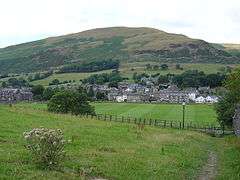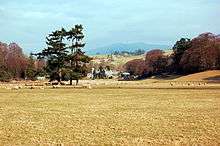Sedbergh
Sedbergh (/ˈsɛdbər/ SED-bər or locally /ˈsɛbər/ SEB-ər) is a small town and civil parish in Cumbria, England. Historically in the West Riding of Yorkshire, it lies about 10 miles (16 km) east of Kendal,[2] 28 miles (45 km) north of Lancaster and about 10 miles (16 km) north of Kirkby Lonsdale, just within the Yorkshire Dales National Park. It stands at the foot of the Howgill Fells on the north bank of the River Rawthey, which joins the River Lune about 2 miles (3 km) below the town.
| Sedbergh | |
|---|---|
 | |
 Sedbergh Location within Cumbria | |
| Population | 2,765 (2011)[1] |
| OS grid reference | SD6592 |
| Civil parish |
|
| District | |
| Shire county | |
| Region | |
| Country | England |
| Sovereign state | United Kingdom |
| Post town | SEDBERGH |
| Postcode district | LA10 |
| Dialling code | 015396 |
| Police | Cumbria |
| Fire | Cumbria |
| Ambulance | North West |
| UK Parliament | |

Situation
Sedbergh has a narrow main street lined with shops. From all angles, the hills rising behind the houses can be seen. Until the coming of the Ingleton Branch Line in 1861, these remote places were reachable only by walking over some steep hills. The line to Sedbergh railway station ran from 1861 to 1954.
The civil parish covers a large area, including the hamlets of Millthrop, Catholes, Marthwaite, Brigflatts, High Oaks, Howgill, Lowgill and Cautley, the southern part of the Howgill Fells and the western part of Baugh Fell.
George Fox, a founder of the Religious Society of Friends (Quakers), spoke in the churchyard of St. Andrew's Church (which Quakers of the day called a "steeple house") and on nearby Firbank Fell during his travels in the North of England in 1652. Briggflatts Meeting House was built in 1675. It is the namesake of Basil Bunting's long poem Briggflatts (1966). Sedbergh School is a co-educational boarding school in the town; Settlebeck School is its main state-funded secondary school.
History
Sedbergh's parish church, dedicated to St Andrew, dates from the 12th century, although restored periodically since then. There is at least one house in the village dating from the 14th century, and there are remains of a motte and bailey castle believed to date from Saxon times.
Sedbergh's main industries for many years were farming and the production of woollen garments. Wool was taken to mills for spinning into yarn, from which people in their homes knitted clothing such as hats and socks. The garments were sold, for instance, to the coal miners of the North-East England. This trade of long ago is remembered at Farfield Mill,[3] just outside the town, which has an exhibition of weaving equipment and workshops for a number of artists and crafts workers.
Governance
Sedbergh belongs to the Westmorland and Lonsdale parliamentary constituency, of which Tim Farron is the current Liberal Democrats member.[4] Before Brexit, it was in the North West England European Parliamentary Constituency.
For local government purposes Sedbergh is in the Kirkby Lonsdale ward of South Lakeland District Council, which covers towns and surroundings with a combined population of 6,369 at the 2011 Census .[5] It belongs to the Sedbergh + Kirkby Lonsdale Division of Cumbria County Council.
Sedbergh has its own parish council.[6]
Economy and amenities
Personal incomes now come from a range of sources: the schools are major employers. Sedbergh is also England's official book town (like Hay-on-Wye in Wales and Wigtown in Scotland). Though smaller than these, it has several independent bookshops and dealers.[7] It is possible that the employment in small to medium manufacturing and wholesale companies matches or exceeds that of schools – a growing feature of the economy. Other major sources of income are farming, retail and tourism. The profile of Sedbergh rose considerably after it featured in a BBC documentary series, The Town that Wants a Twin, airing for twelve episodes in January and February 2005.[8][9] One result was for Sedbergh to twin with Zreče in north-eastern Slovenia.[10]
The town suffered an outbreak of foot-and-mouth disease in 2001. As livestock farming declined, it has been promoted as a destination for walkers and ramblers. In 2015 the town was accepted as a Walkers are Welcome town.
The town golf club is located at Catholes-Abbott Holme.[11]
A monthly booklet "Sedbergh and District Lookaround" gives details of events and activities in the town and its organisations, along with times of buses and religious services. It is available at local shops for a suggested donation of £1. Online copies are available from its website.[12]
Landmarks
Ingmire Hall, about two miles west of the town, consists of the remains of a 16th-century house, including a pele tower, altered and enlarged in the 19th century by the Kendal architect George Webster,[13] and again in the 20th century. It was damaged by fire in the 1920s, but extended and partly remodelled in 1989. It is built of coursed rubble with quoins and slate roofs. Although the hall is in private grounds, there is a public footpath along the driveway.[14]
St Gregory's Church is a redundant Anglican church on the A684 road about 1.5 miles/2 km west of Sedbergh. It is designated a Grade II listed building, recorded in the National Heritage List for England, maintained by Historic England and under the care of the Churches Conservation Trust.
The Cross Keys Inn is a 400-year-old pub now run by the National Trust.
Location grid
See also
- Listed buildings in Sedbergh
- Sedbergh School
- Slingsby T.21, glider known in RAF service as the Sedbergh
References
- "Parish population 2011". Neighbourhood Statistics. Office for National Statistics. Retrieved 12 June 2015.
- "Sedbergh Geographical and Historical information from the year 1868". GENUKI. Retrieved 17 May 2011.
- "Tim Farron". theyworkforyou.com. Archived from the original on 1 June 2013.
- "Key Figures for 2011 Census: Key Statistics – Area: Sedbergh and Kirkby Lonsdale (Ward)". Neighbourhood Statistics. Office for National Statistics. Retrieved 17 March 2017.
- "Sedbergh Parish Council".
- "Book Sellers". Visit Sedbergh.
- "Sophie Honey - GOV.UK". www.gov.uk.
- "Search Results – BBC Genome". genome.ch.bbc.co.uk. Retrieved 27 May 2017.
- "Google". www.google.com.
- "Sedbergh Golf Club". www.sedberghgolfclub.com.
- Sedbergh Lookaround.
- listing, The Cumbrian Castle. "Ingmire Hall, Sedergh".
- "Ingmire Hall".
External links
| Wikimedia Commons has media related to Sedbergh. |
| Wikivoyage has a travel guide for Sedbergh. |
- Sedbergh website
- Sedbergh Gateway website – Information for Walkers and Cyclists
- Cumbria County History Trust: Sedbergh (nb: provisional research only – see Talk page)
- An illustrated guide to Sedbergh
- Sedbergh Book Town
- Sedbergh pictures and information
- Farfield Mill and water turbine - video footage